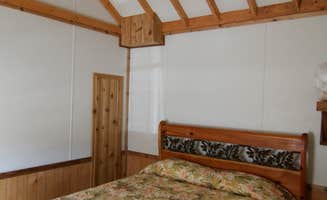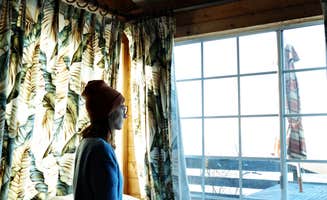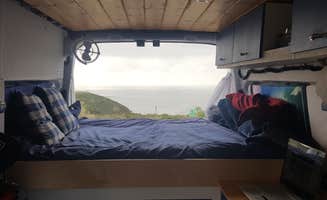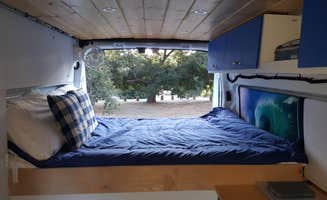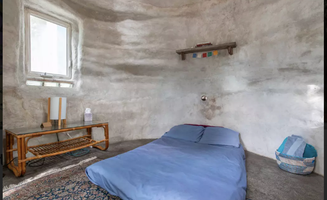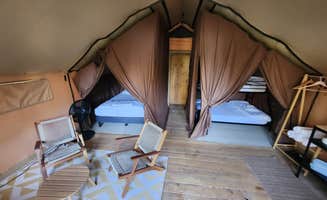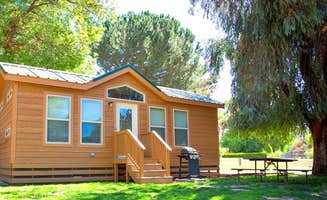Glamping near Anaheim, California exists within a coastal climate zone where average temperatures range between 60-80°F during peak camping season. The proximity to the Pacific Ocean creates moderate year-round conditions with less than 15 inches of annual rainfall, primarily between November and March. Campgrounds in this region feature both natural terrain and developed facilities within urban settings, creating unique outdoor experiences with varying degrees of amenities.
What to do
Hiking nearby trails: Crystal Cove State Park offers extensive trail systems connecting directly to camping areas. "I stayed at the lower campsite... and I think this was the best spot in the campground as it had an unobstructed view of the water and was far enough away from others, but still easy to get to the restroom if needed," notes one backpacker at Moro Campground — Crystal Cove State Park. The park features trails ranging from 1 to 12 miles with varying difficulty levels.
Beach activities: Many luxury camping options provide direct or nearby beach access. "The beach has less crowds/tourists/homeless compared to other beaches. It's really quite and peaceful," explains a visitor to Crystal Cove Beach Cottages. Beach access points often include amenities like concessions and tide pools for exploration.
Water recreation: Seasonal water activities are available at select locations. At Newport Dunes, "They have activities for the kids like arts and crafts, an inflatable obstacle course or you can rent paddle boards or watch a movie on the beach," mentions a repeat visitor. The lagoon area features safe swimming zones specifically designed for families with younger children.
What campers like
Convenience to attractions: Most upscale camping facilities position themselves as base camps for Southern California exploration. At Anaheim Harbor RV Park, one visitor appreciated that "Very good park, well kept and clean. Onsite bathrooms, showers, office and clubhouse. Small pool no hotub. Friendly neighbors great long term stay."
Privacy options: Even in urban settings, some campgrounds offer secluded accommodations. A visitor to Ronald W. Caspers Wilderness Park shared, "Lots of trees to segment the sites, so even though the neighbors are 30' ish away... you are quite secluded." Site separation techniques include vegetation barriers, terraced layouts, and strategic positioning.
Clean facilities: Maintenance standards remain high across luxury camping options. According to a recent guest at Canyon RV Park, "I have been here for a few months and I love it here... The staff is friendly and the whole RV park is beautiful. Bathrooms are clean and they even have fun events on many of the weekends." Most facilities employ daily cleaning schedules for shared restrooms and shower facilities.
What you should know
Reservation requirements: Premium glamping accommodations often book months in advance, particularly during summer and holiday weekends. Most sites require deposits ranging from $40-200 depending on accommodation type and length of stay.
Noise considerations: Despite natural settings, some locations experience ambient urban sounds. At Crystal Cove State Park, "You can hear PCH traffic in the distance (sirens, loud motorcycles), but this really was the perfect, quick getaway into the backcountry right in the middle of Orange County."
Military-only options: Some of the most exclusive glamping facilities restrict access to military personnel and families. "This is a military only RV Park. Very clean, cement slab, walking paths well lit and near to many areas to explore. Wetlands on the base and birds galore," notes a visitor to Seabreeze At Seal Beach. Proper identification is required for entry at these locations.
Tips for camping with families
Pool access: Many upscale camping facilities include swimming amenities. At Newport Dunes RV Resort, families appreciate that "We spent time in the pool. After that I cooked dinner at our site while my daughters watched television in the adjacent club house. Afterwards they went swimming again."
Wildlife viewing: Nature observation opportunities exist even in urban-adjacent settings. "Plenty of squirrels, bunnies, the occasional deer and coyotes at night, signs warning you are now in mountain lion territory," reports a camper at Caspers Wilderness Park. Most parks provide interpretive programs or nature centers with information about local species.
Safety features: Security measures vary by location but often include controlled access points and staff presence. "Security was great and super friendly. Roomy camping spots and amazing views," notes a family at Moro Campground. Many premium glamping locations maintain 24-hour staff availability for emergencies or assistance.
Tips from RVers
Site selection strategy: RV sites vary significantly in size, amenities, and positioning. "The sites are terraced, so no matter which site you get you'll have a view of the ocean," explains an RVer about Moro Campground. Request specific site numbers when making reservations based on your rig size and preference for privacy.
Hookup considerations: Utility connections differ between standard and premium sites. "If you have a larger RV or slide-outs it is recommended you book Deluxe space or Deluxe space+ parking," advises an experienced camper. Most premium glamping locations offer 30/50 amp service with water and sewer connections at designated sites.
Park layout knowledge: Understanding facility layouts helps maximize the camping experience. "There are only two tent sites (T1 and T3), the rest are for RVs," notes a tent camper at Anaheim Harbor. Familiarize yourself with campground maps before arrival to locate amenities like dump stations, water fill points, and laundry facilities.


